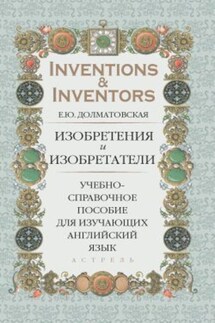Изобретения и изобретатели. Учебно-справочное пособие для изучающих английский язык - страница 8
In 1888 George Eastman introduced the first Kodak camera, which used a cylindrical shutter that the photographer turned by pulling a string on the front of the camera. It made photography available to amateurs for the first time and created a snapshot craze at the turn of the 20th century.. In 1884 Eastman patented the first film in roll form to prove practicable; in 1888 he perfected the Kodak camera, the first camera designed specifically for roll film. The Kodak was one of the earliest handheld cameras.
In 1925 the Leitz Company in Germany introduced the Leica, one of the first cameras to use 35-millimeter film, a small-sized film initially designed for motion pictures. Because of its compactness and economy, the Leica and other 35-millimeter cameras became popular with both amateur and professional photographers.
Words
a. Nouns
aperture отверстие
bellows мех фотоаппарата
blind шторка
camera obscura камера обскура («темная комната»)
daguerreotype дагерротип
diaphragm диафрагма
film пленка
image образ; изображение; отражение
lens линза, оптическое стекло; лупа; объектив
plate пластина
recording регистрация, запись (чего-л. куда-л.)
shutter затвор фотообъектива
spool шпулька, катушка; бобина
surface поверхность
b. Adjectives
light-tight светонепроницаемый
light-sensitive светочувствительный
Exercises
Complete the table using information from the text
a. Write a paragraph, describing camera obscura. Translate your paragraph into Russian
b. Write a paragraph giving the comparison of the camera obscura and the modern camera. Use the first paragraph of the text “Camera” as a support.
a. Name all the steps in the development of the camera in photography during the 19th and 20th centuries.
b. Speak on the functions of the components of any modern camera.
2.2 Saxophone
The saxophone or sax is a conical instrument of the wind family, usually made of brass and played with a single-reed mouthpiece like the clarinet.
The saxophone was created in the early 1840s by Adolphe Sax, a Belgian-born instrument-maker and clarinetist working in Paris, and was first officially revealed to the public in the patent of 1846. He drew up plans for 14 different types of saxophones, but they were not all realized.
It is likely that Sax’s intent was to invent an entirely new instrument which suited his desires both tonally and technically and possessed a new level of flexibility. This would explain why he chose to name the instrument the “voice of Sax.” In short, Sax intended to harness the finesse of a woodwind with the power of a brass instrument. The saxophone is most commonly associated with popular music, big band music, and jazz, but it was originally intended as both an orchestral and military band instrument.
Construction. The saxophone combines in its construction the single reed and mouthpiece of the clarinet, a metal body, and a widened version of the conical bore of the oboe. The body contains openings, covered by keys, which can be opened or closed in groups by means of finger plates, operated by the fingers of either hand. Most saxophones are curved at the end and resemble the bass clarinet; a few, such as the soprano saxophone, are straight and resemble the standard clarinet. The most common saxophones are the soprano, the alto, the tenor, and the baritone. The tone quality ranges from soft, flutelike, and mellow to brassy and metallic.There is some debate amongst players as to whether the curve affects the tone or not.


